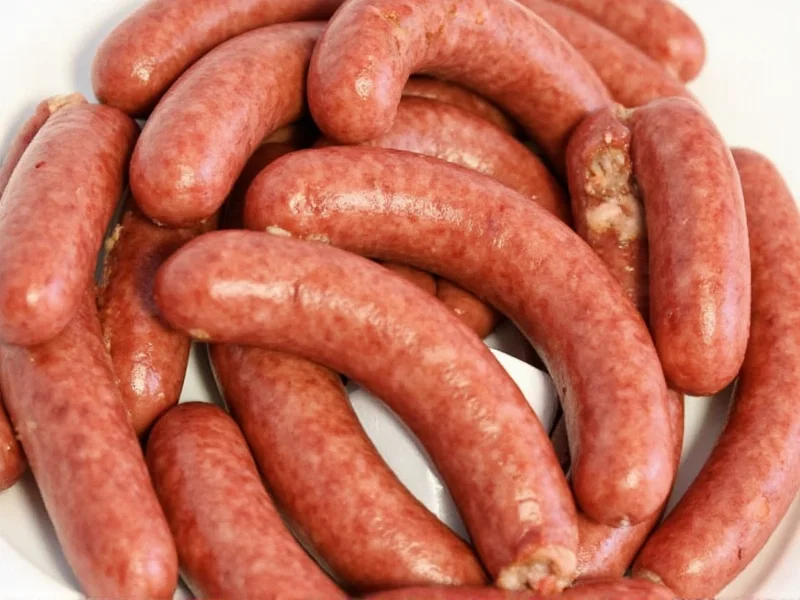Properly cooked sausage isn't just about taste—it's a critical food safety issue. Undercooked sausage can harbor harmful bacteria like Salmonella, E. coli, and Trichinella that cause serious foodborne illnesses. Knowing exactly when your sausage is safely cooked protects you and your family while ensuring optimal texture and flavor.
Why Proper Sausage Cooking Temperature Matters
Sausage presents unique food safety challenges compared to whole cuts of meat. Because it's ground, any bacteria present on the surface gets distributed throughout the product. This means sausage must be cooked to higher temperatures than whole-muscle meats to eliminate pathogens completely.
The USDA Food Safety and Inspection Service establishes precise temperature requirements for different sausage types. These aren't suggestions—they're scientifically determined thresholds that destroy dangerous microorganisms. Ignoring these guidelines risks food poisoning that can cause severe gastrointestinal distress, hospitalization, and in rare cases, long-term health complications.
The Gold Standard: Using a Meat Thermometer
While many home cooks rely on visual cues, the only foolproof method to determine if sausage is cooked properly is with an instant-read meat thermometer. Visual indicators can be misleading, especially with sausages containing fillers, seasonings, or nitrites that affect color.
Here's how to use a thermometer correctly:
- Insert the probe into the thickest part of the sausage, avoiding contact with the cooking surface
- Wait 10-15 seconds for an accurate reading (follow your thermometer's instructions)
- Check multiple sausages in the batch, as cooking can be uneven
- Clean the probe with hot, soapy water between readings
| Sausage Type | Safe Internal Temperature | Additional Notes |
|---|---|---|
| Pork, Beef, Lamb Sausage | 160°F (71°C) | No pink color should remain |
| Chicken or Turkey Sausage | 165°F (74°C) | Requires higher temperature than red meat sausages |
| Pre-cooked Smoked Sausage | 140°F (60°C) | Heating through is sufficient as it's already cooked |
Visual and Textural Indicators (When Thermometer Isn't Available)
If you don't have a thermometer, these secondary indicators can help determine if sausage is cooked, though they're less reliable:
- Color change: Properly cooked pork sausage should have no pink color remaining. Note that some sausages with nitrites may retain a pink hue even when fully cooked.
- Texture: Cooked sausage should feel firm to the touch, not soft or squishy. When pressed, it should spring back rather than indent.
- Juices: Clear or faintly yellow juices indicate doneness. Red or pink juices mean it needs more cooking time.
- Cutting test: As a last resort, slice into one sausage to check for pinkness. Note that this causes moisture loss and should be avoided if possible.
Cooking Times by Method
Cooking times vary significantly based on method and sausage thickness. These are general guidelines for raw sausages:
| Cooking Method | Approximate Time | Key Tips |
|---|---|---|
| Pan-frying | 15-20 minutes | Cook over medium heat, turning frequently for even browning |
| Grilling | 12-18 minutes | Use indirect heat first, then finish over direct heat for char |
| Baking | 20-25 minutes at 375°F | Place on rack to allow fat to drip away |
| Boiling then browning | 10-12 minutes boiling + 5 minutes browning | Ensures thorough cooking before achieving crispy exterior |
Special Considerations for Different Sausage Types
Not all sausages have the same cooking requirements. Understanding these differences is essential for food safety:
- Pork sausages: Must reach 160°F (71°C). Despite outdated beliefs, modern pork is safe at this temperature without being dry.
- Chicken and turkey sausages: Require higher temperature (165°F/74°C) due to salmonella risks in poultry.
- Pre-cooked sausages: Only need to be heated through to 140°F (60°C), but verify packaging instructions.
- Smoked sausages: Many are fully cooked but benefit from heating. Always check labels—"smoked" doesn't always mean "cooked."
- Vegetarian sausages: Follow package instructions as they don't require the same temperatures as meat products.
Common Mistakes That Lead to Undercooked Sausage
Avoid these frequent errors that compromise food safety:
- Relying solely on color: Seasonings and preservatives can keep sausage looking pink even when fully cooked.
- Not checking multiple pieces: Sausages cook unevenly, especially when crowded in the pan.
- Guessing cooking time: Thickness, starting temperature, and cooking method all affect required time.
- Cutting to check too early: This releases juices, leading to dry sausage and inaccurate visual assessment.
- Ignoring resting time: Sausage continues cooking internally for several minutes after removal from heat.
The Importance of Resting Time
After reaching the proper internal temperature, remove sausages from heat and let them rest for 3-5 minutes. This allows:
- Temperature to stabilize and carryover cooking to complete
- Juices to redistribute throughout the sausage
- Proteins to relax, resulting in more tender texture
- Final safety margin as temperature remains above danger zone
During this critical resting period, the internal temperature typically rises 5-10 degrees, providing an additional safety buffer against pathogens.
Food Safety Reminders
Follow these additional practices to ensure sausage is safely prepared:
- Always wash hands, utensils, and surfaces that contact raw sausage
- Never partially cook sausage and finish later—that keeps it in the danger zone (40°F-140°F) too long
- Store raw sausage below 40°F and use within 1-2 days of purchase
- When in doubt about doneness, cook it longer—undercooked sausage isn't worth the risk











 浙公网安备
33010002000092号
浙公网安备
33010002000092号 浙B2-20120091-4
浙B2-20120091-4